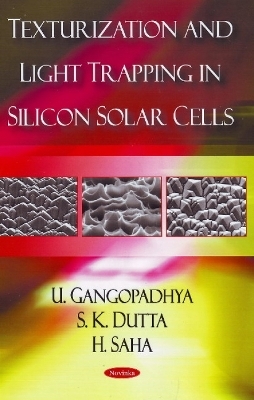
Texturization & Light Trapping in Silicon Solar Cells
Seiten
2009
Nova Science Publishers Inc (Verlag)
978-1-60692-081-7 (ISBN)
Nova Science Publishers Inc (Verlag)
978-1-60692-081-7 (ISBN)
Reduction of optical losses in both mono and multicrystalline silicon solar cells by surface texturing is one of the important issues of modern silicon photovoltaics. This book discusses different novel texturization techniques for monocrystalline silicon including solar cells performance.
Reduction of optical losses in both mono and multicrystalline silicon solar cells by surface texturing is one of the important issues of modern silicon photovoltaics. Texturing of the front surface of silicon solar cells has been modeled and analysed with reference to the reduction in reflection co-efficient and increase in optical trapping. Significant enhancement in open circuit voltage and short circuit current has been achieved through such texturing of the front surface of mono-silicon solar cells. A proper optimisation of texture angle appears to be important for the best performance of the solar cells. An alternative way of reducing the surface reflection and enhancement of the cell parameters is to produce to passive front surface porous silicon layer. An analysis of the characteristics of a porous silicon layer shows that the morphology of the layer is an important design parameter. To realise the structures in practice, several methods are available, but many of this method are either not cost effective or commercially non available. In order to achieve good uniformity of pyramidal textured structure of the silicon surface, a mixture of NaOH/KOH and isopropyl alcohol (IPA) is generally used for texturization of mono crystalline solar cells. However, due to high cost of IPA, there is always search for alternative source. This source should not only be cost effective but should also result in reduced interfacial energy between silicon and ionised electrolyte chemical solution to achieve sufficient wet-ability for the silicon surface in order to enhance pyramid nucleation. Different novel texturization techniques for monocrystalline silicon are descried in this chapter including solar cells performance. For multicrystalline silicon (mc-Si) solar cells, the standard alkaline solution of NaOH/KOH does not produced textured surface of good quality so as to give satisfactory open circuit voltage and efficiency. This is because of grain boundary delineation with step formed between successive grains of different orientations. Different novel texturization techniques for multicrystalline silicon are also included in this book including solar cells performance.
Reduction of optical losses in both mono and multicrystalline silicon solar cells by surface texturing is one of the important issues of modern silicon photovoltaics. Texturing of the front surface of silicon solar cells has been modeled and analysed with reference to the reduction in reflection co-efficient and increase in optical trapping. Significant enhancement in open circuit voltage and short circuit current has been achieved through such texturing of the front surface of mono-silicon solar cells. A proper optimisation of texture angle appears to be important for the best performance of the solar cells. An alternative way of reducing the surface reflection and enhancement of the cell parameters is to produce to passive front surface porous silicon layer. An analysis of the characteristics of a porous silicon layer shows that the morphology of the layer is an important design parameter. To realise the structures in practice, several methods are available, but many of this method are either not cost effective or commercially non available. In order to achieve good uniformity of pyramidal textured structure of the silicon surface, a mixture of NaOH/KOH and isopropyl alcohol (IPA) is generally used for texturization of mono crystalline solar cells. However, due to high cost of IPA, there is always search for alternative source. This source should not only be cost effective but should also result in reduced interfacial energy between silicon and ionised electrolyte chemical solution to achieve sufficient wet-ability for the silicon surface in order to enhance pyramid nucleation. Different novel texturization techniques for monocrystalline silicon are descried in this chapter including solar cells performance. For multicrystalline silicon (mc-Si) solar cells, the standard alkaline solution of NaOH/KOH does not produced textured surface of good quality so as to give satisfactory open circuit voltage and efficiency. This is because of grain boundary delineation with step formed between successive grains of different orientations. Different novel texturization techniques for multicrystalline silicon are also included in this book including solar cells performance.
Introduction; Models of Texturisation; Technology for Realizing Texturisation for Monocrystalline Silicon Solar Cell; Multicrystalline Silicon Etching for Solar Cell Fabrication; Index.
| Erscheint lt. Verlag | 1.1.2009 |
|---|---|
| Zusatzinfo | Illustrations, unspecified |
| Verlagsort | New York |
| Sprache | englisch |
| Maße | 230 x 155 mm |
| Gewicht | 188 g |
| Themenwelt | Technik ► Elektrotechnik / Energietechnik |
| ISBN-10 | 1-60692-081-2 / 1606920812 |
| ISBN-13 | 978-1-60692-081-7 / 9781606920817 |
| Zustand | Neuware |
| Haben Sie eine Frage zum Produkt? |
Mehr entdecken
aus dem Bereich
aus dem Bereich
Kolbenmaschinen - Strömungsmaschinen - Kraftwerke
Buch | Hardcover (2023)
Hanser (Verlag)
49,99 €


